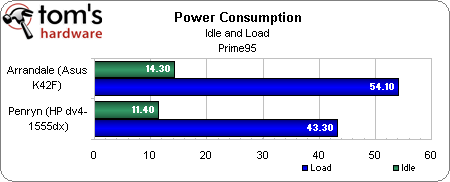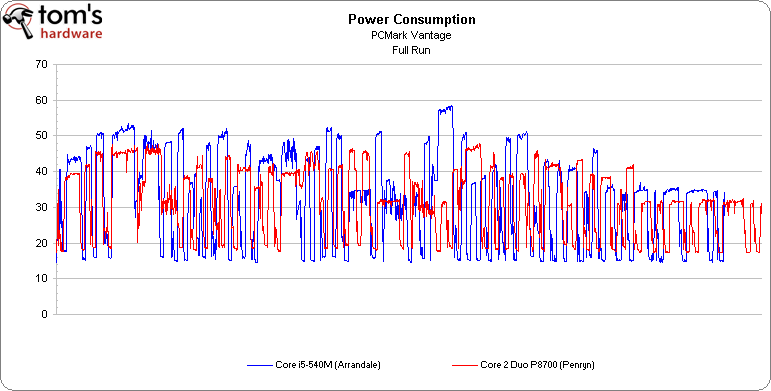Intel’s Mobile Core i5 And Core i3: Arrandale Is For The Rest Of Us
Power Consumption
The Core i5-540M is a 35W processor, whereas Intel’s Core 2 Duo P8700 is a 25W part. Thus, it’s hardly a surprise to see the Montevina platform using less power in Prime95 than the newer Calpella design (note that these numbers were taken with no battery installed).
In fact, we certainly expected Arrandale to use more power under load based on our previous experiences with Core i7-920XM. In that story, we saw Turbo Boost and Hyper-Threading maximizing performance, depending on workload, at the expense of power consumption, whereas Core 2 Quad (or Duo, in this case) is unable to deliver a dynamic performance story.
The match-up gets much closer at idle. Although the i5-540M sports a higher TDP and two-die package, it also employs a two-chip platform and power gating to minimize the consumption of unused resources.
However, these min./max. figures don’t tell the whole story, so we also recorded a PCMark Vantage run on each notebook and charted out power use at two second intervals.
Although the 35W Core i5-540M clearly uses more power under load, it also dips well under the Core 2 Duo P8700 during Vantage’s down-time, despite the load/idle numbers above.
When you even out all of the peaks and valleys, you get 32.9W average power consumption for the Arrandale processor and 31.7W for the Penryn-based Core 2 Duo. When we factor in the fact that the Core i5-540M system finished the test 2:26 faster than the Core 2 Duo, dropping back to idle as the other machine completed its workload, we’re able to conclude that there’s finally evidence of Nehalem-based processors outdoing Core 2 when it comes to overall power consumption. The performance story tells itself. Arrandale is clearly the quicker chip, too.
This is something we’ve been waiting on for a while now. First, we heard about power gating, which would shut down unused processing cores almost completely. Then there was the inclusion of PCI Express and memory control with Lynnfield. Adding Windows 7 to the mix was supposed to optimize power usage further. But each step along the way, we saw the Nehalem design using more power than we had expected. “Wait for Arrandale, wait for Arrandale, wait for Arrandale,” was what we kept hearing. Now that Arrandale is upon us, we see the wait was worthwhile. The two-chip platform architecture, heavy integration, and shift to 32nm manufacturing means it’s now possible to get significantly better performance from a dual-core, four-thread CPU at lower overall power use than a comparably-equipped dual-core notebook based on Core 2.
Get Tom's Hardware's best news and in-depth reviews, straight to your inbox.
-
burnley14 Well played, Intel. You've been knocking it out of the park lately, keep up the good work.Reply -
I'm looking forward to getting an HP laptop with the Arrandale Core i5 processor in the near future.Reply
-
It's going to be interesting to see the performance/battery time of the LM and UM processors as I'm in the market for a thin-and-light myself.Reply
Performance is good but I'm hoping for a viable update to the CULV offerings of yesterday. -
Computer_Lots Looks like there are finally some replacements for the Atom, at least in efficiency anyway. Too bad the price is currently too high for the UM versions of these processors to make their way into netbooks. I would guess that even the i5-520UM would destroy the Atom in every benchmark, except maybe power consumption.Reply -
HansVonOhain C2D was one of the longest living platforms. But newer tech will replace slower processors.Reply
Keep it up intel. I do hope that AMD will release some new chips that will be able to compete with intel offerings. -
jasperjones ^^^ true that. arrandale will further diminish AMD's role in the mobile processor market. and there's nothing coming up before may.Reply -
Luscious Chris, the dv4 series from HP has a 12-cell extended battery available as well rated for 94Wh 2.2A. Once HP makes the transition to Arrandale, all else being same, you can expect the dv4 to hit 8-10 hours easy.Reply -
cangelini Thanks for the tip Lucious. I didn't have the higher-capacity battery available to test, but I'd absolutely love to see 8-10 hrs. real-world from an Arrandale-based machine.Reply -
Reynod Good bye NVidia ...Reply
That chops them completely out of the mobile graphics market for the masses ... Intel will pay the RIGHT OEM's some "adjustment" just to make sure their "Strategy" is right to ensure AMD's mobile market is thin and restricted to the backwaters of Bejjing.


